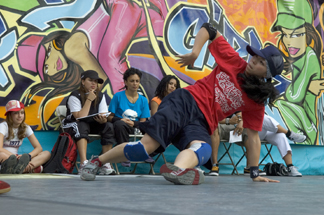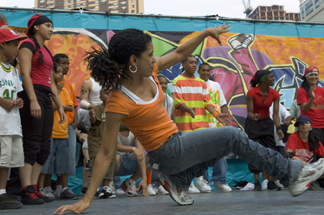
(845) 246-6944
· info@ArtTimesJournal.com
 |
By
Dawn Lille
ART
TIMES October 2006
Lincoln Center Out
of Doors, which just completed its 36th year of being, is free.
This means that everyone of every background and age, representing all
of New York City and beyond, could, from morning until evening, observe,
participate in and enjoy every aspect of the performing arts, both in
the guise of formal staged performances and a series of “special” events,
some meant specifically for children.
There
was dance, music, spoken word and interactive family programs. One might
speculate on the definition of performance, but if it is considered as
a form of entertainment in which the performer communicates to those watching,
at a site that can be anywhere, then Lincoln Center fits right in and
the boundaries of traditional western theatre are broken.
Reynold
Levy, President of Lincoln Center, has been criticised for bringing popular
entertainment to this “high brow” center of New York. His response was
that he wants those who cannot afford the tickets for theatre, dance and
music to feel comfortable and welcome in the environment, which should
be a space for all. Regardless of how one felt about the gentleman submerged
in the water tank in front of Lincoln Center last spring (and this writer
was part of the intermission audience at the Opera House that surged onto
the terrace to try to catch a glimpse of his emergence), the Out of Doors
program of over 100 events in three weeks was a glorious, warm gathering
precipitated by performance.
As
is to be expected in such an endeavour, not all events were of equal worth.
However, considering the difficulties encountered by any performer out
of doors – the vagaries of the weather, the need to project sound
and movement into an endless space, the competition with airplanes, sirens,
crying infants and traffic – the accomplishments of this festival
under the skies were so many that they cannot be covered in one column.
But it must be noted that even in the ‘midst of one of the worst downpours
of the summer, which caused the Lulu Washington Dance Theatre and the
Reggie Wilson/Fist and Heel Performance Group to be cancelled, everyone
was cheerful. The makeshift tent, created by “borrowing” a backstage tarpaulin
that was carried at its outside edges, stopped every few feet to encompass
babies being wheeled, elderly people taking shelter on the ledges of the
opera house and lots of ordinary wet citizens. It was a great disappointment
to miss these two exhilarating companies that were part of the special
festival celebration, “The Spirit of The Blues,” but the spirit manifested
itself in the rhythmic stepping under the blue cover and the wet smiles.
 |
The
programs that adhered to this theme and others, in many cultures and art
forms, included performances from Mali, Greece, Spain, India, Latin America
and the Caribbean. The Afro-Peruvian music and dance troupe Peru Negro
was part of the festival, as well as a piece called Lacuna, created
by Tom Pearson, a Native-American choreographer. This work, concerned
with the issue of cultural identity in a public space, something that
Lincoln Center Out of Doors has always hinted at, combined traditional
American Indian music, contemporary music and experimental dance.
What follows are some examples of dance that are only a selection
of the many. The wonderful music programs, including the Roots of American
Music Festival, are not covered.
We
B*Girlz, a hip hop event presented on the raised stage on Josie Robertson
Plaza, right behind the fountain, was, in many ways, emblematic of the
entire festival. It celebrated
the first Breakin’ event at Lincoln Center twenty-five years ago, when
break dancing and hip hop belonged to the male gender. Some of those alumni
came on stage to do a turn and say a few words of gratitude for the preservation
of the culture, but this was, basically, a girls night.
Twenty-five years ago so many men showed up for the “battle” there were
over 200 dancers on stage and no one could see what was taking place.
Here, four three-girl crews competed in front of a varied and vociferous
audience and a panel of judges. The latter came from Sweden, Great Britain,
Holland, Brooklyn and the Bronx, showing that hip hop has become a worldwide
phenomenon.
The host for the event was Toni Blackman, a female rapper. She emphasized
the fact that hip hop is about people and the elevation of the people.
She reminded everyone that, in form, it is crowd participatory and she
urged those present to react as they saw fit. Before the battle began,
the order of appearance was decided by pulling names out of a hat. Each
crew was timed in its presentation and then each was given a second opportunity.
A former break dancer sitting next to me, delighted at seeing what was
part of his youth, was most helpful in explaining the difference between
the “old” school, which was more physical and involved more balance, and
the “new,” dating from the 90’s, which involved head twirls, jumping,
flipping and mime. The girls combined both in group and solo moves, including
hands on hips challenges to the other crews, who came from London, Philadelphia,
New York and New Jersey. The choice of the winner was based on attitude,
power, style, individuality and creativity. The audience did not agree
with the final decision and let the judges know it. I was quietly with
the audience.
The
Carpet Brigade Physical Theater Company from San Francisco performed Mudfire,
billed as a fire ritual. Inspired by forest fires, the eight dancers,
all but one on nine-foot stilts, presented an amalgam of stories about
humans, animals and Greek gods. There was a monster, various acrobatic
feats on stilts, some partnered ballroom dancing and an attempt to draw
the imagination into a journey of good versus evil. Although it did not
work as dance theatre, the many children in the audience loved the circus
feeling and began to emulate the movement
 |
The Martha Graham Dance Company concert took place in the Damrosch Park
Band Shell, where every seat was occupied long before performance time.
The overflow stood and sat on the stone walls and clustered behind the
seats. This crowd included those familiar with the company and the program
of Graham classics they danced, many young dancers and, from listening
to conversations, others who knew of the company but had never seen it.
A presentation called Dance Off! Happy Hour took place on the Robertson Plaza at 5:00
P.M., ensuring an audience of many families. Curated by Terry Dean Bartlett
and Katie Workum, who ended the program clad in evening dress, she playing
the cello and he doing back flips on a mattress, the performance included
excerpts from eight works from eight companies. The best known of the
choreographers were Annie-B Parson, Robert Battle and Ivy Baldwin.
The instructions must have been to create light, humorous works. Since
humor is one of the most difficult things to accomplish in the theatre,
especially in dance, it will come as no surprise that not all of these
bits were funny. The most successful were Couple #2 by Larry Keigwin, a tongue-in-cheek sensual duet that
made fun of the lyrics of “Baby I Love You” and a duet by Ryan Bronz in
which two masked figures in black, carrying surfboards, cavorted to “I’m
Sailing Away.” This sampling program made dance accessible to all and
Bartlett’s exhortation to check the website of each company and buy tickets
to their programs opened up the possibility of a continuing relationship
between the performers and this audience.
Nii Tettey and the Kusun Ensemble from Ghana are a group of musicians and
dancers who are taking traditional West African music and dance as their
base and are trying to develop new music and dance that they call “Nokoko.”
There were seven items on their program, three of them pure music. Tetteh
is a composer and musician and the group is most successful when its excellent
musicians play his compositions and arrangements, which do expand the
range of African music. The four dancers presented several traditional
pieces and one of the men had the most expressive face and eyes seen in
a long time.
The Jazz Center of New York, under Cobi Narita, presented the Victor Lin
Trio (Lin on piano, David Wong on bass and Quincy Davis on drums) and
a Challenge Tap Jam. It was held in Damrosch Park in the area of the trees,
with chairs set up wherever there was space around a raised platform.
Again, each seat was occupied and others sat, stood and kneeled wherever
possible, the leaves rustling gently above them. A short program that
should have been longer, it completely captured an audience that ranged
from children in strollers to some very knowledgeable jazz fans.
This was perhaps the most satisfying of the events I saw. It combined excellent
technique with joyful communication. The space was able to contain the
sound under the shelter of the trees, and most were able to see and hear
the dancers.
Public art, especially sculpture, has always been a part of the festival
and this year’s entry, “Big Pleasure Point” by Nancy Rubins, was perched
right in front and could be seen from multiple avenues of approach. Rubins,
known for her work with industrial materials and consumer goods, created
a work that used more than sixty small pleasure boats –canoes, kayaks,
rowboats. Held in place by heavy cables, it created a tension of objects
resembling a multi- pointed starburst exuding energy that streamed into
its surroundings from a strong and mysterious core. The fact that the
boats were recognizable as objects, albeit transformed, made it accessible,
amusing and satisfying.
Lincoln Center Out of Doors, which began in 1971 as a small street festival
intended to create an interaction between the community and the cultural
institution, has commissioned almost eighty works and presented major,
emerging, traditional and experimental dance and music to an average of
200,000 people each summer. Long may it continue!